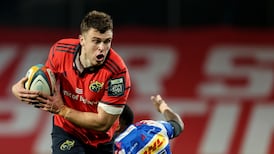England fullback Mike Brown's boot collided more than once with Conor Murray's face in a ruck during last Saturday's Six Nations Championship match at Twickenham. The Ireland scrumhalf required eight stitches to a wound in the corner of his eye and did not return for the final nine minutes of the game.
Shaun Veldsman, the television match official (TMO) for the game, ruled the contact as "accidental", having been directed by referee Romain Poite to review the incident.
The Six Nations-appointed citing commissioner for the game, Scotland's Douglas Hunter, determined in the 48-hour review window, that the English player had no case to answer.
Brown tweeted in the aftermath that his actions were acceptable on foot of the TMO’s call. The England fullback’s actions appeared reckless rather than malicious, but there is a provision in the sport’s laws (10.4 c, Kicking an opponent) that does not absolve a player just because the contact was accidental.
The law currently provides for a censure to punish players for recklessly if unintentionally causing injury and ultimately they should be responsible for their actions.
At a time when World Rugby is very keen to promote player welfare – the brain trauma/ concussion issue should remain at the top of the agenda – it seems ludicrous to permit an action on a pitch that is dangerous in the extreme. The consequences of a kick delivered to the head or temple by an 18-stone player, however accidental, could in itself be a concussive blow.
Common sense
Does an international player have to lose an eye, several teeth or be knocked unconscious before there is an appreciation that flailing away with a boot in proximity to the head and face of a prone player – potentially off balance or shunted by an opponent of team-mate inadvertently changing the plane of the kicking motion – is unlikely to have a positive outcome?
Or will it require an incident in an underage game before there is a consensus that there is no acceptable level of collateral damage in an accident not adjudicated to be reckless?
Common sense should illuminate the way forward.
Toulon's Romain Taofifenua received a three-week ban for kicking Ulster's Stuart Olding in the head during a European match in 2014. He was aiming for the ball but struck the head because he was off balance and wrestling with a player. It was accidental, but it was also reckless.
Leinster's Fergus McFadden was also called to account for catching Connacht's Nathan White with a boot to the head and he too received a three-week ban. So where is the consistency?
A statement issued by Six Nations’ organisers outlining the disciplinary cases arising from the weekend revealed that Brown had avoided any action being taken for an act that was reviewed at the time on the big screen by referee Poite and TMO Veldsman.
Further review
Hunter was the ultimate arbiter of whether the incident required further review. This is not a witch-hunt against Brown.
His actions merely highlight an increasingly popular action within a sport where the tariff of being a millimetre off is one that is simply way too high to pay.
Ireland coach Joe Schmidt said in the aftermath of the game that there was no malice in Brown's actions but he was correct in asserting later that World Rugby needed to review the gambit of players attempting to draw a kick at a ball in a ruck situation. "They have people who look at those things and I have never, ever tried to influence that. The one thing that I did identify is it is something that appears to be a strategy because there is a lot of kicking the ball out of the ruck," Schmidt said.
“It’s probably something that even the lawmakers or the officials have to have a bit of a look at regarding player safety, particularly with the head and particularly the eyes, as it was in this incident.
“Conor has got eight stitches in the corner of his eye. There was a bit of fear that there might be damage to the eye but there’s not thankfully.”
Italian tighthead prop Martin Castrogiovanni has been cited under law 10.4 (b) for stamping/trampling on the toe of an opponent and faces a hearing on Wednesday.












